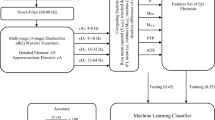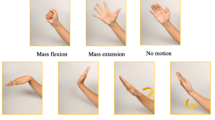Abstract
Keeping a minimal number of channels is essential for designing a portable brain–computer interface system for daily usage. Most existing methods choose key channels based on spatial information without optimization of time segment for classification. This paper proposes a novel subject-specific channel selection method based on a criterion called F score to realize the parameterization of both time segment and channel positions. The F score is a novel simplified measure derived from Fisher’s discriminant analysis for evaluating the discriminative power of a group of features. The experimental results on a standard dataset (BCI competition III dataset IVa) show that our method can efficiently reduce the number of channels (from 118 channels to 9 in average) without a decrease in mean classification accuracy. Compared to two state-of-the-art methods in channel selection, our method leads to comparable or even better classification results with less selected channels.







Similar content being viewed by others
Notes
We provide the locations of electrodes selected by CSL instead of CSTI for comparison, since this part of analysis is based on the whole time period for 3C setup.
References
Allison BZ, Wolpaw EW, Wolpaw JR. Brain–computer interface systems: progress and prospects. Expert Rev Med Dev. 2007;4(4):463–74.
Alotaiby T, El-Samie FEA, Alshebeili SA, Ahmad I. A review of channel selection algorithms for EEG signal processing. EURASIP J Adv Signal Process. 2015;2015(1):1–21.
Ansuini C, Cavallo A, Koul A, Jacono M, Yang Y, Becchio C. Predicting object size from hand kinematics: a temporal perspective. PLoS One. 2015;10(3):e0120432.
Barachant A, Bonnet S. Channel selection procedure using Riemannian distance for BCI applications. In: 5th international IEEE/EMBS conference on neural engineering (NER 2011). 2011; p. 348–351.
Blankertz B, Dornhege G, Krauledat M, Müller KR, Kunzmann V, Losch F, Curio G. The Berlin brain–computer interface: EEG-based communication without subject training. IEEE Trans Neural Syst Rehabil Eng. 2006;14(2):147–52.
Blankertz B, Müller KR, Krusienski DJ, Schalk G, Wolpaw JR, Schlögl A, Pfurtscheller G, Millán JR, Schroder M, Birbaumer N. The BCI competition III: validating alternative approaches to actual BCI problems. IEEE Trans Neural Syst Rehabil Eng. 2006;14(2):153–9.
Blankertz B, Tomioka R, Lemm S, Kawanabe M, Müller KR. Optimizing spatial filters for robust EEG single-trial analysis. IEEE Signal Process Mag. 2008;25(1):41–56.
Duan L, Zhong H, Miao J, Yang Z, Ma W, Zhang X. A voting optimized strategy based on ELM for improving classification of motor imagery BCI data. Cogn Comput. 2014;6(3):477–83.
Gouy-Pailler C, Congedo M, Brunner C, Jutten C, Pfurtscheller G. Nonstationary brain source separation for multiclass motor imagery. IEEE Trans Biomed Eng. 2010;57(2):469–78.
Gouy-Pailler C, Sebag M, Larue A, Souloumiac A. Single trial variability in brain-computer interfaces based on motor imagery: learning in the presence of labeling noise. Int J Imaging Syst Technol. 2011;21(2):148–57.
Graimann B, Pfurtscheller G. Quantification and visualization of event-related changes in oscillatory brain activity in the time-frequency domain. Progr Brain Res. 2006;159:79–97.
He L, Hu Y, Li Y, Li D. Channel selection by Rayleigh coefficient maximization based genetic algorithm for classifying single-trial motor imagery EEG. Neurocomputing. 2013;121:423–33.
Jain A, Zongker D. Feature selection: evaluation, application, and small sample performance. IEEE Trans Pattern Anal Mach Intell. 1997;19(2):153–8.
Jasper HH. The ten-twenty electrode system of the International Federation. Electroencephalogr Clin Neurophysiol. 1958;10(2):371–5.
Kyrgyzov O, Bloch I, Yang Y, Wiart J, Souloumiac A. Data ranking and clustering via normalized graph cut based on asymmetric affinity. In: Image Analysis and Processing–ICIAP 2013. Springer; 2013. p. 562–571.
Lal TN, Schröder M, Hinterberger T, Weston J, Bogdan M, Birbaumer N, Schölkopf B. Support vector channel selection in BCI. IEEE Trans Biomed Eng. 2004;51(6):1003–10.
Li Y, Koike Y. A real-time BCI with a small number of channels based on CSP. Neural Comput Appl. 2011;20(8):1187–92.
Lotte F, Congedo M, Lécuyer A, Lamarche F, Arnaldi B. A review of classification algorithms for EEG-based brain-computer interfaces. J Neural Eng. 2007;4:R1–14.
McFarland DJ, Wolpaw JR. Brain–computer interface operation of robotic and prosthetic devices. Computer. 2008;41(10):52–6.
McFarland Dennis J, McCane Lynn M, David Stephen V, Wolpaw Jonathan R. Spatial filter selection for EEG-based communication. Electroencephalogr Clin Neurophysiol. 1997;103(3):386–94.
Müller KR, Krauledat M, Dornhege G, Curio G, Blankertz B. Machine learning techniques for brain-computer interfaces. Biomed Eng Biomed Tech. 2004;49(1):11–22.
Naeem M, Brunner C, Pfurtscheller G. Dimensionality reduction and channel selection of motor imagery electroencephalographic data. Comput Intell Neurosci. 2009;1–8:2009.
Naji M, Firoozabadi M, Azadfallah P. Classification of music-induced emotions based on information fusion of forehead biosignals and electrocardiogram. Cogn Comput. 2014;6(2):241–52.
Neuper C, Wörtz M, Pfurtscheller G. ERD/ERS patterns reflecting sensorimotor activation and deactivation. Progr Brain Res. 2006;159:211–22.
Pfurtscheller G, Brunner C, Schlögl A, Lopes da Silva FH. Mu rhythm (de)synchronization and EEG single-trial classification of different motor imagery tasks. NeuroImage. 2006;31(1):153–9.
Schlögl A, Brunner C. BioSig: a free and open source software library for BCI research. Computer. 2008;41(10):44–50.
Shan H, Xu H, Zhu S, He B. A novel channel selection method for optimal classification in different motor imagery BCI paradigms. Biomed Eng Online. 2015;14(1):93.
Vidaurre C, Kramer N, Blankertz B, Schlögl A. Time domain parameters as a feature for EEG-based brain–computer interfaces. Neural Netw. 2009;22(9):1313–9.
Wang J, Xue F, Li H. Simultaneous channel and feature selection of fused EEG features based on sparse group lasso. BioMed Res Int 2015;2015:703768.
Wang Y, Gao S, Gao X. Common spatial pattern method for channel selection in motor imagery based brain-computer interface. In: 27th IEEE annual international conference of the engineering in medicine and biology society (EMBS 2005). 2006; p. 5392–5395.
Wolpaw JR, Birbaumer N, McFarland DJ, Pfurtscheller G, Vaughan TM. Brain–computer interfaces for communication and control. Clin Neurophysiol. 2002;113(6):767–91.
Yang Y, Chevallier S, Wiart J, Bloch I. Automatic selection of the number of spatial filters for motor-imagery BCI. In: 20th European symposium on artificial neural networks, computational intelligence and machine learning (ESANN 2012). 2012; p. 109–114.
Yang Y, Chevallier S, Wiart J, Bloch I. Time-frequency selection in two bipolar channels for improving the classification of motor imagery EEG. In 34th IEEE annual international conference of engineering in medicine and biology society (EMBC 2012). 2012; p. 2744–2747.
Yang Y, Chevallier S, Wiart J, Bloch I. Time-frequency optimization for discrimination between imagination of right and left hand movements based on two bipolar electroencephalography channels. EURASIP J Adv Signal Process. 2014;2014(1):38.
Yang Y, Kyrgyzov O, Wiart J, Bloch I. Subject-specific channel selection for classification of motor imagery electroencephalographic data. In: IEEE international conference on acoustics, speech and signal processing (ICASSP 2013). 2013; p. 1277–1280.
Yang Y, WiartJ, Bloch I. Towards next generation human–computer interaction–brain–computer interfaces: applications and challenges. In: 1st international symposium of Chinese CHI (Chinese CHI 2013). 2013; p. 1–2.
Yong X, Ward RK, Birch GE. Sparse spatial filter optimization for EEG channel reduction in brain-computer interface. In: IEEE international conference on acoustics, speech and signal processing (ICASSP 2008). 2008; p. 417–420.
Acknowledgments
Authors would like to thank Dr. Olexiy Kyrgyzov and Dr. Teodoro Solis-Escalante for their useful discussions and Prof. Benjamin Blankertz for providing the BCI dataset: open access BCI dataset, i.e. the dataset IVa [5] from BCI competition III (http://www.bbci.de/competition/iii/). This work was partially supported by grants from China Scholarship Council and Orange Labs.
Author information
Authors and Affiliations
Corresponding author
Ethics declarations
Conflict of Interest
Yuan Yang, Isabelle Bloch, Sylvain Chevallier, and Joe Wiart declare that they have no conflict of interest.
Informed Consent
All procedures followed were in accordance with the ethical standards of the responsible committee on human experimentation (institutional and national) and with the Helsinki Declaration of 1975, as revised in 2008 (5).
Human and Animal Rights
This article does not contain any studies with human or animal subjects performed by the any of the authors.
Rights and permissions
About this article
Cite this article
Yang, Y., Bloch, I., Chevallier, S. et al. Subject-Specific Channel Selection Using Time Information for Motor Imagery Brain–Computer Interfaces. Cogn Comput 8, 505–518 (2016). https://doi.org/10.1007/s12559-015-9379-z
Received:
Accepted:
Published:
Issue Date:
DOI: https://doi.org/10.1007/s12559-015-9379-z




